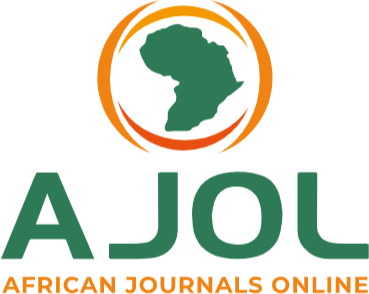Assessment of Aliphatic Hydrocarbons in Soils from Selected Areas in Agbarho Communities, Delta State, Nigeria
Keywords:
aliphatic hydrocarbons, molecular weight, molecular indices, Agbarho communityAbstract
Wisdom Ivwurie, and Gabriel A. Akindeju
The occurrence of petroleum hydrocarbons in the environment has been remarkably discouraging in recent times due to the impeding toxicity of most hydrocarbons. In this study, the presence of aliphatic hydrocarbons was assessed in primary sources and in anthropogenic impacted soils within the Agbarho communities in Delta State, Nigeria. The petroleum hydrocarbons were quantified using gas chromatography equipped with flame ionization detector (GC-FID) after extraction and clean-up of the extracts with nhexane/dichloromethane (1:1 v/v). The evaluated concentrations of the total aliphatic hydrocarbons in the primary
sources ranged from 1,788,030 to 5,368,702µg kg-1 while the concentrations of the total hydrocarbon were within the range, 813 to 11900 µg kg-1 . Source activities variation in the concentrations of the total aliphatic hydrocarbon in anthropogenic impacted
soils was observed to followed the following trend, Mechanic Workshop Soil > Barbecue spot soil > Filling Station Soil > Motor Way
Soil > Traffic point soil. On the average, the concentrations of the higher molecular weight n-alkanes (> C31 in the studied soils) were the highest. Evaluated molecular indices of the investigated aliphatic hydrocarbons showed that the aliphatic hydrocarbons in these soils might have originated from different anthropogenic sources such as petrogenic and terrestrial biogenic sources.
Downloads
Published
Issue
Section
Most read articles by the same author(s)
- Ivwurie Wisdom, Okorodudu, E.Oghenetega, Assay of Aliphatic Hydrocarbons in Soils from Selected Areas in Ughelli and its Environs, Delta State, Nigeria , Communication In Physical Sciences: Vol. 8 No. 2 (2022): VOLUME 8 ISSUE 2
- Ivwurie Wisdom, Gabriel Akindeju, Assessment of Polycyclic Aromatic Hydrocarbons in Soils from Selected Areas in Agbarho Communities, Delta State, Nigeria , Communication In Physical Sciences: Vol. 8 No. 2 (2022): VOLUME 8 ISSUE 2
Similar Articles
- Ivwurie Wisdom, Gabriel Akindeju, Assessment of Polycyclic Aromatic Hydrocarbons in Soils from Selected Areas in Agbarho Communities, Delta State, Nigeria , Communication In Physical Sciences: Vol. 8 No. 2 (2022): VOLUME 8 ISSUE 2
- Ivwurie, Wisdom, Okorodudu, E.Oghenetega, Assay of Aliphatic Hydrocarbons in Soils from Selected Areas in Ughelli and its Environs, Delta State, Nigeria , Communication In Physical Sciences: Vol. 8 No. 2 (2022): VOLUME 8 ISSUE 2
- Ivwurie Wisdom, Okorodudu, E.Oghenetega, Assay of Aliphatic Hydrocarbons in Soils from Selected Areas in Ughelli and its Environs, Delta State, Nigeria , Communication In Physical Sciences: Vol. 8 No. 2 (2022): VOLUME 8 ISSUE 2
- Wisdom, Ivwurie, Daniel, Okiriguo, Evaluation of n-Alkanes Hydrocarbon from two Communities in Udu Local Government Area, Delta State , Communication In Physical Sciences: Vol. 7 No. 4 (2021): VOLUME 7 ISSUE 4
- Chinwendu Olive Ozoeze, Okenwa Uchenna Igwe, Isolation and Characterizations of a Pentacyclic Glycoside from Methanolic Fraction of Allium sativum (Purple Garlic) Bulbs , Communication In Physical Sciences: Vol. 12 No. 3 (2025): VOLUME 12 ISSUE 3
- Eneni Roberts Inala, BIOACCUMULATION OF ENVIRONMENTAL CONTAMINANTS IN OYSTER (Crassostea sp.) TISSUES IN BAYELSA STATE, NIGERIA , Communication In Physical Sciences: Vol. 12 No. 4 (2025): VOLUME1 2 ISSUE 4
- P. O. Ameh, N. O. Eddy, Theoretical and Experimental Investigations of the Corrosion Inhibition Action of Piliostigma Thonningii Extract on Mild Steel in Acidic Medium , Communication In Physical Sciences: Vol. 3 No. 1 (2018): VOLUME 3 ISSUE 1
- Uduak Bassey Essien, Magdalene E. Ikpi, Alexander I Ikeuba, Nsikak Bassey Essien, Experimental and Computational Chemistry Investigations of Tartaric acid as a Green Corrosion Inhibitor for API 5L X 52 Carbon Steel in 0.5 M HCl , Communication In Physical Sciences: Vol. 7 No. 4 (2021): VOLUME 7 ISSUE 4
- Adewale Victor Kuyinu, Sikiru Salau, Kolawole Samuel Oyeleke, Moshood Abiola Salaam, Design and Construction of a long-lasting solar charging option for an E-Scooter , Communication In Physical Sciences: Vol. 12 No. 6 (2025): Volume 12 ISSUE 6
- Theophilus Obijuru Nelson, Emmanuel John Ekpenyong, Assessing the Efficiencies of Calibration Ratio Estimators for Estimating Mean Weight of Babies in the Presence of Gestational Age Under Stratified Random Sampling , Communication In Physical Sciences: Vol. 12 No. 1 (2024): VOLUME 12 ISSUE 1
You may also start an advanced similarity search for this article.



